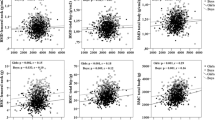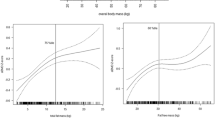Abstract
Summary
With the objective to investigate the relationship of weight and height growth with bone mass at 11 years, we found that boys who grew in weight and height, especially at 48 months, and girls, who grew in weight at 24 months and height at 11 years, gained more bone mass.
Purpose
To investigate independent relationships of linear growth and relative weight gain during defined periods of infancy, childhood, and early adolescence with areal bone mineral density (aBMD) of three sites at 11 years.
Methods
Data on weight and length/height were obtained at birth, 3, 12, and 24 months, and the ages of 4, 6, and 11. The outcome was whole body, femoral neck, and lumbar spine aBMD (g/cm2) measured at 11 years using dual-energy X-ray absorptiometry. The effects of weight gain and linear growth were analyzed using conditional relative weight and conditional length/height. Associations between conditional growth and outcomes were analyzed using linear regression, adjusted for multiple confounders.
Results
Individuals with data available for exposures and bone outcomes were 2875 and comprised the sample. For boys, the greatest magnitude of increase for whole body and height gain was at 48 months (β 0.014, 95% CI 0.010; 0.018). For girls, higher aBMD was observed for those with greater height gain at 11 years, representing for lumbar spine an increase of 0.056 g/cm2 (95% CI 0.050; 0.062). For body weight, among boys, the greatest magnitude in the whole body was also associated with weight gain at 48 months (β 0.014, 95% CI 0.010; 0.018). For girls, the highest coefficient was at 24 months, representing for lumbar spine an increase of 0.028 g/cm2, (95% CI 0.021; 0.035).
Conclusion
Positive associations were demonstrated between length/height and weight gain and aBMD in both sexes, with emphasis on girls’ aBMD in response to the linear growth achieved mainly at 11 years.



Similar content being viewed by others
References
Kontulainen SA, Hughes JM, Macdonald HM, Johnston JD (2007) the biomechanical basis of bone strength development during growth. Med Sport Sci 51:13–32
Davies JH, Evans BAJ, Gregory JW (2005) Bone mass acquisition in healthy children. Arch Dis Child 90:373–378
Mikkola TM, von Bonsdorff MB, Osmond C, Salonen MK, Kajantie E, Cooper C, Välimäki MJ, Eriksson JG (2017) Childhood growth predicts higher bone mass and greater bone area in early old age: findings among a subgroup of women from the Helsinki birth cohort study. Osteoporos Int 28(9):2717–2722
Weaver CM, Gordon CM, Janz KF, Kalkwarf HJ, Lappe JM, Lewis R, O’Karma M, Wallace TC, Zemel BS (2016) The National Osteoporosis Foundation’s position statement on peak bone mass development and lifestyle factors: a systematic review and implementation recommendations. Osteoporos Int 27(4):1281–1386
Golden NH, Abrams SA (2014) Optimizing bone health in children and adolescents. Pediatrics 134:e1229–e1243
Guéguen R, Jouanny P, Guillemin F, Kuntz C, Pourel J, Siest G (1995) Segregation analysis and variance components analysis of bone mineral density in healthy families. J Bone Miner Res 10(12):2017–2022
Krall EA, Dawson-Hughes B (1993) Heritable and life-style determinants of bone mineral density. J Bone Miner Res 8(1):1–9
Dennison EM, Syddall HE, Sayer AA, Gilbody HJ, Cooper C (2005) Birth weight and weight at 1 year are independent determinants of bone mass in the seventh decade: the Hertfordshire cohort study. Pediatr Res 57(4):582–586
Kuh D, Wills AK, Shah I, Prentice A, Hardy R, Adams JE, Ward K, Cooper C, National Survey for Health and Development (NSHD) Scientific and Data Collection Team (2014) Growth from birth to adulthood and bone phenotype in early old age: a British birth cohort study. J Bone Miner Res 29:123–133
Antonisamy B, Vasan SK, Geethanjali FS, Gowri M, Hepsy YS, Richard J, Raghupathy P, Karpe F, Osmond C, Fall CHD (2017) Weight gain and height growth during infancy, childhood, and adolescence as predictors of adult cardiovascular risk. J Pediatr 180:53-61.e3
Christoffersen T, Ahmed LA, Daltveit AK, Dennison EM, Evensen EK, Furberg AS, Gracia-Marco L, Grimnes G, Nilsen OA, Schei B, Tell GS, Vlachopoulous D, Winther A, Emaus N (2017) The influence of birth weight and length on bone mineral density and content in adolescence: The Tromsø Study. Fit Futures Arch Osteoporos 12:54
McCormack SE, Cousminer DL, Chesi A, Mitchell JA, Roy SM, Kalkwarf HJ, Lappe JM, Gilsanz V, Oberfield SE, Shepherd JA, Winer KK, Kelly A, Grant SFA, Zemel BS (2017) Association between linear growth and bone accrual in a diverse cohort of children and adolescents. JAMA Pediatr 171(9):e171769
Adair LS, Fall CH, Osmond C, Stein AD, Martorell R, Ramirez-Zea M et al (2013) Associations of linear growth and relative weight gain during early life with adult health and human capital in countries of low and middle income: findings from five birth cohort studies. Lancet 382(9891):525–534
Santos IS, Barros AJD, Matijasevich A, Domingues MR, Barros FC, Victora CG (2011) Cohort profile: the 2004 Pelotas (Brazil) birth cohort study. Int J Epidemiol 40:1461–1468
Santos IS, Barros AJD, Matijasevich A, Zanini R, Cesar MAC, Camargo-Figuera FA, Oliveira IO, Barros FC, Victora CG (2014) Cohort profile update: 2004 Pelotas (Brazil) birth cohort study. Body composition, mental health and genetic assessment at the 6 years follow-up. Int J Epidemiol 43(5):1437–1437
Lohman T, Roche A, Martorell R (1988) Anthropometric standardization reference manual. Human Kinetics Books, Champaign (IL)
Habicht JP (1974) Estandarización de métodos epidemiológicos quantitativos sobre el terreno. Bol Oficina Sanit Panam 76(5):375–384
Harris PA, Taylor R, Thielke R, Payne J, Gonzales N, Conde JG (2009) Research electronic data capture (REDCap) - a metadata-driven methodology and workflow process for providing translational research informatics support. J Biomed Inform 42(2):377–381
Leonard MB, Elmi A, Mostoufi-Moab S, Shults J, Burnham JM, Thayu M, Kibe L, Wetzsteon RJ, Zemel BS (2010) Effects of sex, race, and puberty on cortical bone and the functional muscle bone unit in children, adolescents, and young adults. J Clin Endocrinol Metab 95(4):1681–1688
Alswat KA (2017) Gender disparities in osteoporosis. J Clin Med Res 9(5):382–387
Leonard MB, Shults J, Elliott DM, Stallings VA, Zemel BS (2004) Interpretation of whole body dual energy x-ray absorptiometry measures in children: comparison with peripheral quantitative computed tomography. Bone 34:1044–1052
Setia S, Sridhar MG (2009) Changes in GH/IGF-1 axis in intrauterine growth retardation: consequences of fetal programming? Horm Metab Res 41(11):791–798
Devlin MJ, Bouxsein ML (2012) Influence of pre- and peri-natal nutrition on skeletal acquisition and maintenance. Bone 50(2):444–451
Goodfellow LR, Cooper C, Harvey NC (2011) Regulation of placental calcium transport and offspring bone health. Front Endocrinol (Lausanne) 2:3
Cianfarani S, Ladaki C, Geremia C (2006) Hormonal regulation of postnatal growth in children born small for gestational age. Hormone Res 65(Suppl 3):70–74
Javaid MK, Godfrey KM, Taylor P, Shore SR, Breier B, Arden NK, Cooper C (2004) Umbilical venous IGF-1 concentration, neonatal bone mass, and body composition. J Bone Miner Res 19(1):56–63
van Coeverden SC, Netelenbos JC, de Ridder CM, Roos JC, Popp-Snijders C, Delemarre-van de Waal HA (2002) Bone metabolism markers and bone mass in healthy pubertal boys and girls. Clin Endocrinol (Oxf) 57(1):107–116
Baird J, Kurshid MA, Kim M, Harvey N, Dennison E, Cooper C (2010) Does birthweight predict bone mass in adulthood? A systematic review and meta-analysis. Osteoporos Int 22:1323–1334
Glass NA, Torner JC, Letuchy EM, Burns TL, Janz KF, Gilmore JME, Schlechte JA, Steven M, Levy SM (2016) The relationship between greater prepubertal adiposity, subsequent age of maturation, and bone strength during adolescence. J Bone Miner Res 31(7):1455–65
Evensen E, Skeie G, Wilsgaard T, Christoffersen T, Dennison E, Furberg AS, Grimnes G, Winther A, Emaus N (2018) How is adolescent bone mass and density influenced by early life body size and growth? The Tromsø Study: Fit Futures-A Longitudinal Cohort Study From Norway. JBMR Plus 2(5):268–280
Nilsen OA, Ahmed LA, Winther A, Christoffersen T, Furberg AS, Grimnes G, Dennison E, Nina Emaus N (2017) Changes and tracking of bone mineral density in late adolescence: the Tromsø Study. Fit Futures Arch Osteoporos 12:37
Theintz G, Buchs B, Rizzoli R, Slosman D, Clavien H, Sizonenko PC, Bonjour JP (1992) Longitudinal monitoring of bone mass accumulation in healthy adolescents: evidence for a marked reduction after 16 years of age at the levels of lumbar spine and femoral neck in female subjects. J Clin Endocrinol Metab 75:1060–1065
van Leeuwen J, Koes BW, Paulis WD, van Middelkoop M (2017) Differences in bone mineral density between normal-weight children and children with overweight and obesity: a systematic review and meta-analysis. Obes Rev 18(5):526–546
Heaney RP (2016) Achieving the protection of high peak bone mass. Osteoporos Int 27(4):1279–1280
Heppe DH, Medina-Gomez C, Hofman A, Rivadeneira F, Jaddoe VW (2015) Does fetal smoke exposure affect childhood bone mass? The Generation R Study Osteoporos Int 26(4):1319–1329
Acknowledgements
This article is based on data from the study “Pelotas Birth Cohort, 2004” conducted by Postgraduate Program in Epidemiology at Universidade Federal de Pelotas, with the collaboration of the Brazilian Public Health Association (ABRASCO). The World Health Organization, National Support Program for Centers of Excellence (PRONEX), Brazilian National Research Council (CNPq) (grant 476727/2003-0), Brazilian Ministry of Health (grants FNS-2799-03 and FNS-4589-04), and Children’s Pastorate supported the perinatal phase of the study. AM, AJDB, LTR, FCB, and ISS are supported by CNPq.
Author information
Authors and Affiliations
Corresponding author
Ethics declarations
Conflict of interest
None.
Additional information
Publisher's note
Springer Nature remains neutral with regard to jurisdictional claims in published maps and institutional affiliations.
Supplementary Information
Below is the link to the electronic supplementary material.
Rights and permissions
Springer Nature or its licensor (e.g. a society or other partner) holds exclusive rights to this article under a publishing agreement with the author(s) or other rightsholder(s); author self-archiving of the accepted manuscript version of this article is solely governed by the terms of such publishing agreement and applicable law.
About this article
Cite this article
Bierhals, I.O., Vaz, J.d., Matijasevich, A. et al. Linear growth and relative weight gain in childhood and bone mass in adolescence: findings from the Pelotas (Brazil) 2004 birth cohort. Arch Osteoporos 18, 5 (2023). https://doi.org/10.1007/s11657-022-01189-4
Received:
Accepted:
Published:
DOI: https://doi.org/10.1007/s11657-022-01189-4




